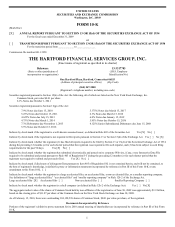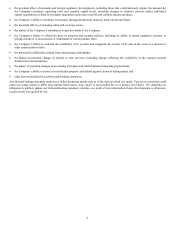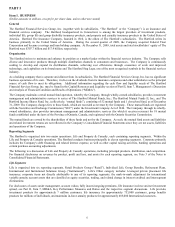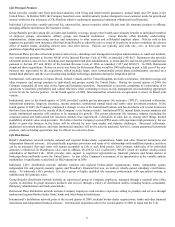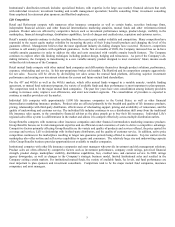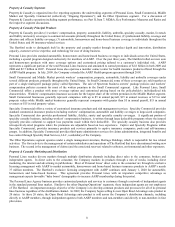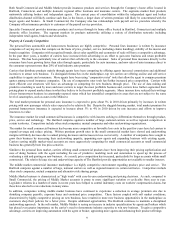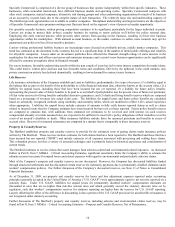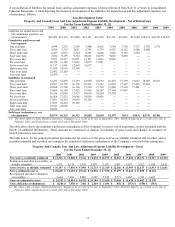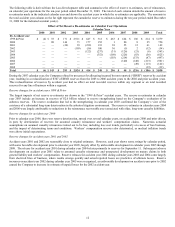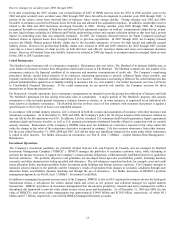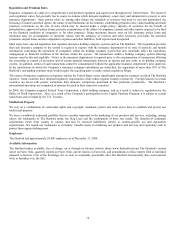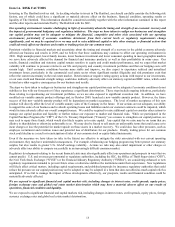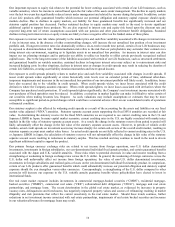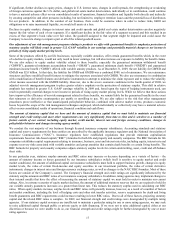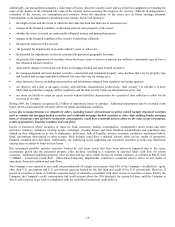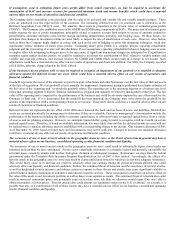The Hartford 2009 Annual Report Download - page 10
Download and view the complete annual report
Please find page 10 of the 2009 The Hartford annual report below. You can navigate through the pages in the report by either clicking on the pages listed below, or by using the keyword search tool below to find specific information within the annual report. 10
Specialty Commercial is comprised of a diverse group of businesses that operate independently within their specific industries. These
businesses, while somewhat interrelated, have different business models and operating cycles. Specialty Commercial competes with
other stock companies, mutual companies, alternative risk sharing groups and other underwriting organizations for much of its business
on an account by account basis due to the complex nature of each transaction. The relatively large size and underwriting capacity of
The Hartford provide opportunities not available to smaller companies. Disciplined underwriting and targeted returns are the objectives
of Specialty Commercial since premium writings may fluctuate based on the segment’ s view of perceived market opportunity.
For specialty casualty business, written pricing competition continues to be significant, particularly for the larger individual accounts.
Carriers are trying to protect their in-force casualty business by starting to renew policies well before the policy renewal date.
Employing this early renewal practice often prevents other carriers from quoting on the business, resulting in fewer new business
opportunities within the marketplace. With national account business, as the market continues to soften, more insureds may opt for
guaranteed cost policies in lieu of loss-sensitive products.
Carriers writing professional liability business are increasingly more focused on profitable private, middle market companies. This
trend has continued as the downturn in the economy has led to a significant drop in the number of initial public offerings and volatility
for all public companies. Losses taken on investment portfolios have affected the financial strength ratings of some insurers in the
marketplace for directors and officers and errors and omissions insurance and a carrier’ s new business opportunities can be significantly
affected by customer perceptions about its financial strength.
For surety business, favorable underwriting results within the past couple of years has led to more intense competition for market share.
This could lead to written price declines and less favorable terms and conditions. Driven by the upheaval in the credit markets, new
private construction activity has declined dramatically, resulting in lower demand for contract surety business.
Life Reserves
Life insurance subsidiaries of the Company establish and carry as liabilities, predominantly, five types of reserves: (1) a liability equal to
the balance that accrues to the benefit of the policyholder as of the financial statement date, otherwise known as the account value, (2) a
liability for unpaid losses, including those that have been incurred but not yet reported, (3) a liability for future policy benefits,
representing the present value of future benefits to be paid to or on behalf of policyholders less the present value of future net premiums;
(4) fair value reserves for living benefits embedded derivative guarantees; and (5) death and living benefit reserves which are computed
based on a percentage of revenues less actual claim costs. The liabilities for unpaid losses and future policy benefits are calculated
based on actuarially recognized methods using morbidity and mortality tables, which are modified to reflect Life’ s actual experience
when appropriate. Liabilities for unpaid losses include estimates of amounts to fully settle known reported claims as well as claims
related to insured events that the Company estimates have been incurred but have not yet been reported. Future policy benefit reserves
are computed at amounts that, with additions from estimated net premiums to be received and with interest on such reserves
compounded annually at certain assumed rates, are expected to be sufficient to meet Life’ s policy obligations at their maturities or in the
event of an insured’ s disability or death. Other insurance liabilities include those for unearned premiums and benefits in excess of
account value. Reserves for assumed reinsurance are computed in a manner that is comparable to direct insurance reserves.
Property & Casualty Reserves
The Hartford establishes property and casualty reserves to provide for the estimated costs of paying claims under insurance policies
written by The Hartford. These reserves include estimates for both claims that have been reported to The Hartford and those that have
been incurred but not reported (“IBNR”) and include estimates of all expenses associated with processing and settling these claims.
This estimation process involves a variety of actuarial techniques and is primarily based on historical experience and consideration of
current trends.
The Hartford continues to receive claims that assert damages from asbestos-related and environmental-related exposures. As discussed
further in Part II, Item 7, MD&A – Critical Accounting Estimates, significant uncertainty limits the Company’ s ability to estimate the
ultimate reserves necessary for unpaid losses and related expenses with regard to environmental and particularly asbestos claims.
Most of the Company’ s property and casualty reserves are not discounted. However, the Company has discounted liabilities funded
through structured settlements and has discounted certain reserves for indemnity payments due to permanently disabled claimants under
workers' compensation policies. For further discussion of the Company’ s discounted reserves, see Note 11 of Notes to Consolidated
Financial Statements.
As of December 31, 2009, net property and casualty reserves for losses and loss adjustment expenses reported under accounting
principles generally accepted in the United States of America (“U.S. GAAP”) were approximately equal to net reserves reported on a
statutory basis. Under U.S. GAAP, liabilities for unpaid losses for permanently disabled workers’ compensation claimants are
discounted at rates that are no higher than risk-free interest rates and which generally exceed the statutory discount rates set by
regulators, such that workers’ compensation reserves for statutory reporting are higher than the reserves for U.S. GAAP reporting.
Largely offsetting the effect of the difference in discounting is that a portion of the U.S. GAAP provision for uncollectible reinsurance is
not recognized under statutory accounting.
Further discussion of The Hartford’ s property and casualty reserves, including asbestos and environmental claims reserves, may be
found in Part II, Item 7, MD&A – Critical Accounting Estimates – Property and Casualty Reserves, Net of Reinsurance.

